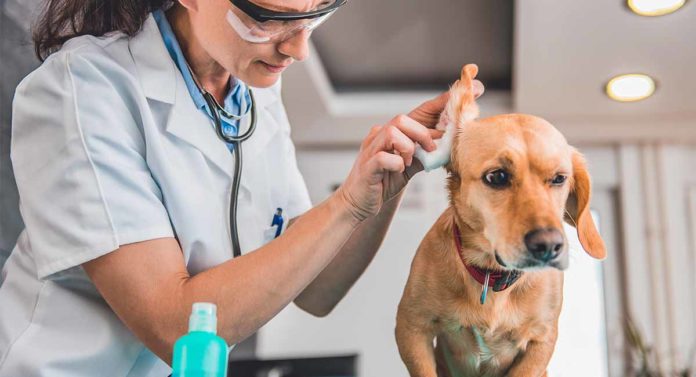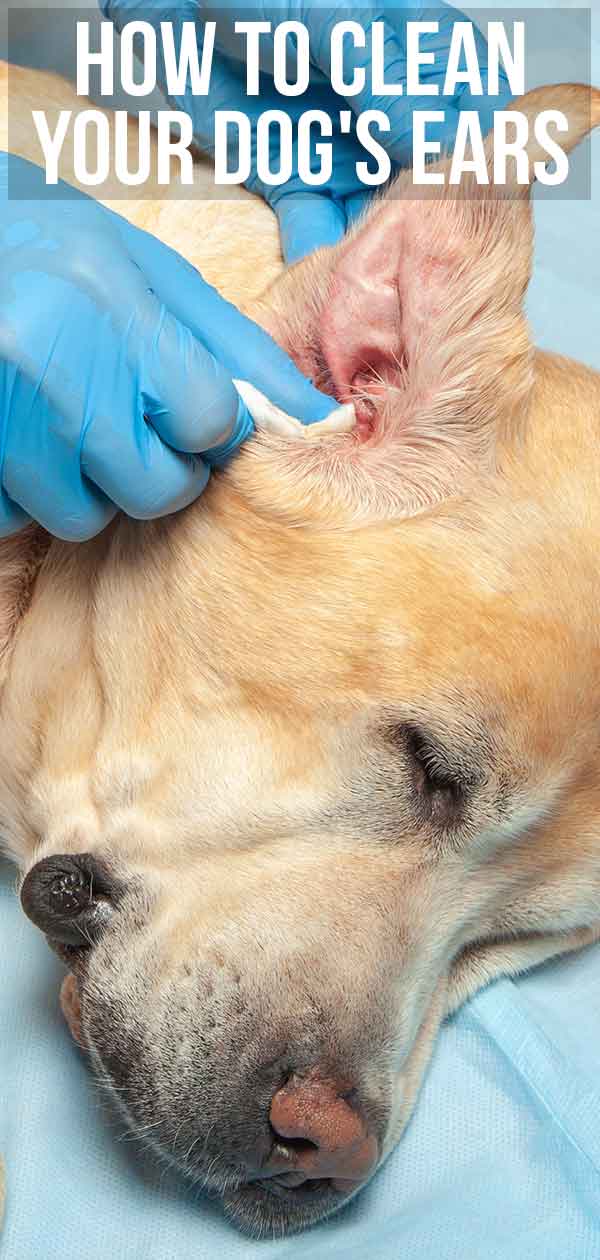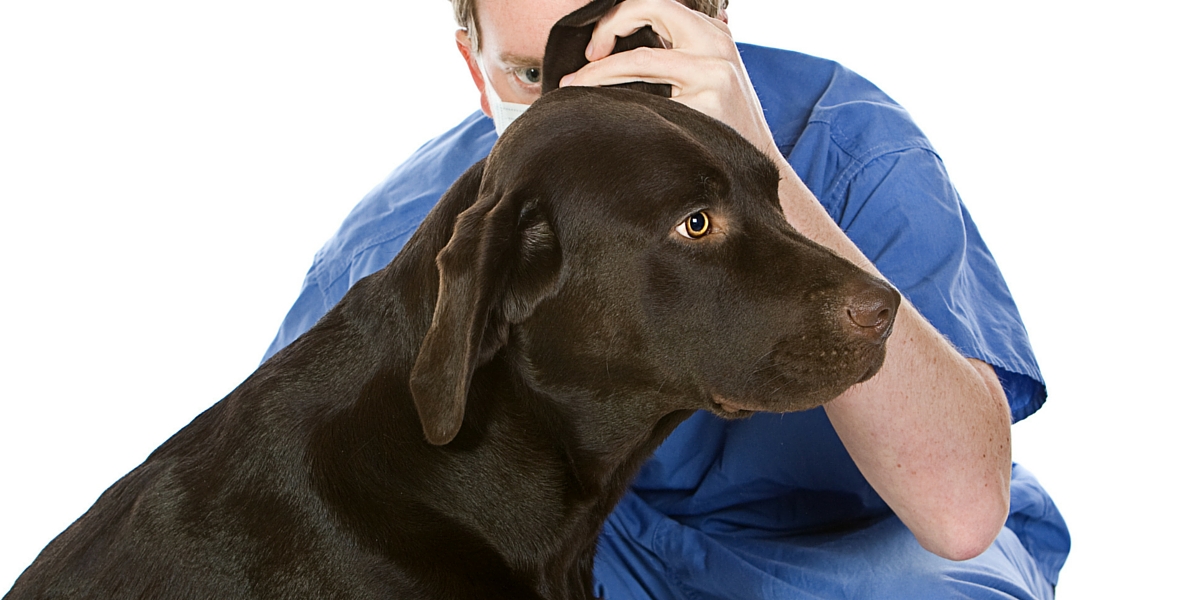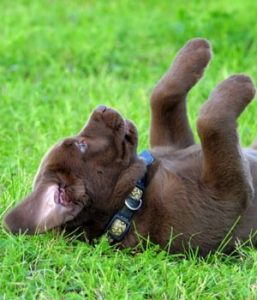How To Get Water Out Of Dog's Ear

If you want to know how to clean dogs' ears, you're in the right place. In this article we explain why dog's ears sometimes need cleaning, and when and how to clean them. Ear problems in dogs do need to be diagnosed and treated by a qualified veterinarian. But healthy ears need cleaning too!
So we'll show you several methods you can use, and take you through the products and equipment you might need. And we'll teach you how to examine your dog's ears, so you can decide for yourself whether it's time for a clean.
Why does my dog need his ears cleaned?
Why should we learn how to clean dogs ears? Well, it is a good practice to examine your pup's ears for not just dirt but debris and infection as well. And while not all Labradors need their ears cleaning, many do. This is for a number of reasons, including the shape of their ears.

Labrador ear structure
Your Labrador's ancestors were wolves, with upright and pointed ears. These ears weren't just evolved to do a great job of detecting sound, they were also practical in terms of hygiene. Large open ear canals not only vastly improved their hearing capabilities, acting like the perfect antennae, but also aided them in staying clean and healthy as well.
Labradors have been selectively bred with a different structure to their ears than their pointy-eared ancestors, and the ear canal is covered with a soft furry flap. While these lovely soft ear flaps give our floppy eared dogs a distinctive look that we find so endearing, floppy ears are less practical from a health perspective. Plus, that soft inner ear fuzz that is so efficient at keeping out small debris is equally as efficient at trapping ear wax which creates a sticky trap for bits of gunk, hair and parasites.
Dog ear problems
A flopped over ear, like the Labrador's, creates a nice, warm environment for germs to thrive in. It also traps dirt, ear wax and all sorts of daily grime deep in the ear canal and inner ear. And is one of the reasons that Labrador ear problems are sadly fairly common. As owners, learning how to clean dogs ears will help keep our dogs comfortable and healthy.

Dogs with hairy ear canals
Another cause of ear trouble in some Labs is an excess of hair inside the ear canal. Whilst some hair is useful for stopping debris moving down the ear canal, excess hair can cause it to block more quickly and make it harder for wax to shift.
You might be tempted to cut or tweeze out your Labrador's inner ear hair if you notice it, but if this is not done carefully, the cropped hairs could fall into the ear canal and potentially cause even more problems.
The best thing to do is to show your vet and ask for their advice on whether any action needs to be taken in this respect. They may suggest they remove the hairs themselves or even advise that ear plucking become a part of your pup's professional grooming routine.
Labradors with small ear canals
Finally, some Labradors have small ear canals relative to the size of their head. Again, this makes it more likely that wax will become lodged and become a breeding ground for bacteria. Impacted wax may also create a host of issues from pain to hearing difficulties.
Keeping your Labrador's ears clean will make them feel more comfortable, and reduce the chances of ear-related health issues. Dogs' ears are sensitive, and having grubby ears can be upsetting for your dog. Keeping your dog's ears clean and healthy will help him to stay happy.
How do I tell when my dog's ears need cleaning?
If you are lucky, your dog's ears may almost never need cleaning, but in others they need cleaning on a regular basis. So how will you know whether an ear cleaning session is in order? You can tell by doing simple checks on a regular basis.
How to check your dog's ears
It is important to check your dogs ears at least once a week. This will ensure you keep on top of his ear health and make sure you catch or prevent any problems early on.
Make sure your Labrador is standing, sitting or lying down comfortably. Begin by calmly stroking his head. You can also give him a piece of kibble or a treat to distract him. Lift the flap of his ear and look into the ear canal.
A healthy dog's ear should be pale pink and not have a scent to it. It should also be fairly free from ear wax, debris, discharge or blood although it may have a few flecks of ear wax dotted around the outer ear. Your dog should not react as though in pain, and they should be comfortable with you handling the ear flap.
When to clean your dog's ears
The right time to clean your dog's ears is when they look a bit grubby! If you notice the ear appears to have a bit of extra dirty build up or the wax is looking thicker or darker then it is time for a cleaning. The ear should still be a healthy, pale pink with no unpleasant odor or broken skin. Be sure to note the difference between a dirty ear and a medically unwell ear. More on that below.
Dog ear cleaning equipment
Cleaning your Labrador's ears can be carried out in one of two ways. Either with water, in what is often referred to as the natural method of cleaning, or using specially designed ear cleaning chemicals. The minimum equipment you will need to clean the external part of your dog's ears are:
• Cotton wool pads or swabs
• Warm water
However, you may also find it useful to have to hand:
• Dog treats (in small pieces, either kibble or tiny bits of cheese work well for most dogs)
• A helpful friend!
To clean the inner ear you will also need
• Canine ear cleaner
Do not use ear cleaner made for humans or other pets, as it may not be as effective or safety tested for use on dogs.
How to clean dogs' ears with warm water
Get your ear cleaning equipment laid out within easy reach. If your Labrador is still a puppy pop him into your lap. If he is fully grown try and encourage him to lay down next to you with his head in your lap.
 Remain calm, petting and reaffirming your dog. Use treats if necessary. A second set of hands may be useful for less confident dogs.
Remain calm, petting and reaffirming your dog. Use treats if necessary. A second set of hands may be useful for less confident dogs.
Soak the cotton wool in warm water. Test the temperature of the water. Ensure if it only warm NOT hot! Squeeze out the excess water to leave the cotton damp not sopping wet.
Lift your dog's ear flap with one hand, and with the other hand softly wipe the cotton wool across the ear. Remove any visible dirt and waxy buildup. Begin close to the ear canal and continue outwards towards the outer rim of the underside of the ear flap
Each time you wipe use a new piece of cotton wool, so that you are not reintroducing any removed dirt and debris back into the ear with subsequent wipes. Only wipe around the external parts of the ear, coming near to but not entering the opening of the ear canal. Do not introduce water or cotton wool into the ear canal.
If your dog appears happy and settled you can repeat this right away with the other ear. If he is becoming restless or stressed, then wait until they have settled down before continuing with the other ear.
How to Clean Dogs' Ears with Canine Ear Cleaner
If you have visited your vet due to concerns regarding your Labrador's ears, he might give you some internal ear cleaning solution to use periodically in his ear canal. This usually comes in a tube fitted with a pointed nozzle, so that the liquid is directed into the ear canal.
You can also buy proprietary ear cleaning solutions online. We like Zymox but always check with your vet before using this or any other commercial ear cleaner on your dog. Always follow the instructions given by your vet or on the package carefully.
This will often be along the lines of placing the tube at the entrance to the ear canal, squirting the requisite volume of solution directly into the ear and then massaging the ear and the area beneath it with the ear flap closed. You will hear a squelching sound as the solution cleans the inner ear and while the ear will become damp there should not be a lot of solution leaking out of the ear if the correct amount is used.
Use cotton swabs to wipe out any excess cleaning solution wiping from the inside to outside of the ear flap. Remember excess moisture is one of the factors that fosters infections so drying your dog's ears is very important!
You can help your Labrador to find the process less frustrating by giving him a high value treat immediately after you have massaged the solution into his ear. This will help them associate the less than pleasant ear cleaning with the much more enjoyable reward of a yummy treat.
Your dog's reaction to ear cleaning
After you have flushed your dog's ears, dried them and you release him, you may find that he runs in circles around the room (a case of the zoomies!), shaking his head or rubbing his ears on the floor. This is perfectly normal.
Still it is probably best to carry out the cleaning process in a relatively empty, well contained space away from any fragile items–a bathroom is often preferred. You may be able to distract your dog afterwards with a game or a brisk walk.
How to Have an Easy dog Ear Cleaning Session
Some dogs do not like having their ears cleaned. This can be an issue for some dogs with general cleaning, even more so for dogs with recurring inner ear problems who need routine inner ear cleanings. The best thing you can do is to get your dog used to being handled and having their ears cleaned from a young age.
How to Get a Puppy Used to Having His ears Cleaned
If you are bringing home a new puppy, then every few days when he is sitting on your lap calmly gently stroke around his ears, lifting the flaps and doing a visual check.When he responds by staying calm and still give him a small piece of kibble as a reward. This will help him to get used to letting you inspect the ear, and see it as a rewarding experience when he shows the desired behavior.

When you are happy with these checks, you can do the same but with the occasional gentle wipe of the ear using a damp cotton wool pad. Just remember to reward him for being still, disinterested and calm, and to ignore him when he gets excited.
How to get an older dog used to having his ears cleaned
If your dog is older and has developed a distaste to having his ears checked or cleaned you can combat this but at a very slow, patient pace. The best place to start is by training a reliable sit command. Check out our detailed "train your dog to sit" guide for more information.
Make sure your dog will happily sit while you are both on the same level and while you have your hands on a a body part or area in which he is comfortable. Gradually over the course of several training sessions move your hands closer to his head and ears. Only go as far as your dog is comfortable, and every time he remains relaxed give him a piece of kibble to reward him.
Begin repeating the process with a cotton wool pad or the ear cleaner in your hand. If he is nervous of these items you will need to begin training by simply rewarding him for staying calm when you hold them in the same room as him. You will have to judge how far and how quickly you can move in each session by your dog's reaction. Remember, it should be a rewarding experience in which you are gradually growing your dog's confidence.
When you get near your dog's head and ears with the cleaner, make sure you have lots of high value rewards ready. Stay calm and confident in your handling of him. If you have a friend that your Lab knows well and trusts, then you may find it easier to carry out the final stage with them treat-streaming (giving a continuous row of small treats) while you do the cleaning.
More than just dirty ears?
Sometimes it is more than simply a matter of dirty ears. If your dog exhibits any of the symptoms below you should consult with your veterinarian.
Ear Infection
The most common ear issue in dogs is an ear infection, either bacterial or fungal in nature. Signs your dog may have an ear infection include:
- Sticky discharge from the ear
- Ears become red and inflamed
- Shaking of the head
- Scratching at the ears
- Rubbing the ear on surfaces or the floor
- Bleeding from the ear (in extreme cases)
- Unpleasant odor in the ear
Ear Mites
Ear mites are a very small parasite that live almost exclusively within the ear of mammals. They feed on the shed skin cells, ear wax and oils inside the ear. Signs your dog may have ear mites include:
- Scratching of the ears
- Rubbing the ear on surfaces or the floor
- Shaking their head
- A dark, grainy discharge in the outer ear
Getting Help with Cleaning Your Dog's Ears
Labradors are generally healthy dogs, but their ears can be a problem area so it is important to stay on top of your dog's ear health with regular checks and cleaning when necessary.
If you have any doubts about how to care for your Labradors ears, or if your Labrador is showing any symptoms of infection or ear discomfort, then please contact your local vet for advice. Do not be tempted to leave it to see if it will get better on it's own, as untreated ear infections can be both painful and serious, even leading to deafness.
Remember to ask for help from a friend or family member, and have a regular routine for caring for your dog's ears either at home, with your groomer or with your vet.

How to Clean Dogs' Ears – Summary
Labradors are prone to poor ear health so vigilance is very important. Check your dog's ears frequently, at least once a week. You can clean your dog's ears at home with a cotton swab and warm water solution. Never wipe into the ear canal. Clean only the easy to reach areas.
Clean from the inside of the ear towards the outside of the ear flap. Use only specially formulated canine ear cleaning solution for inner ear cleaning. Learn the difference between your dog's clean ears, dirty ears and unhealthy ears. If you notice any signs of poor ear health do not try to treat at home. Contact your vet.
It is best to get puppies accustomed to having their ears handled from early on. Be patient with training an older dog who is afraid of the ear cleaning process. Create and maintain an ear grooming schedule to maintain ear health
References
Study of Lipid in the Ear Canal in Canine Otitis Externa with Malassezia pachydermatis Akira MASUDA, Takeshi SUKEGAWA, Naoe MIZUMOTO, Hiroyuki TANI, Tadashi MIYAMOTO, Kazumi SASAI, Eiichiroh BABA
Efficacy of fluralaner against Otodectes cynotisinfestations in dogs and cats
Janina Taenzler, Christa de Vos, Rainer K. A. Roepke, Régis Frénais, Anja R. Heckeroth
A survey of mycotic otitis externa of dogs in Lisbon Fernando Manuel Bernardo1, Hermínia Marina Martins2 and Maria Lígia Martins2

The Labrador Site Founder

Pippa Mattinson is the best selling author of The Happy Puppy Handbook, the Labrador Handbook, Choosing The Perfect Puppy, and Total Recall.
She is also the founder of the Gundog Trust and the Dogsnet Online Training Program
Pippa's online training courses were launched in 2019 and you can find the latest course dates on the Dogsnet website
How To Get Water Out Of Dog's Ear
Source: https://www.thelabradorsite.com/how-to-clean-your-labradors-ears/
Posted by: farrararkmadesain.blogspot.com

0 Response to "How To Get Water Out Of Dog's Ear"
Post a Comment